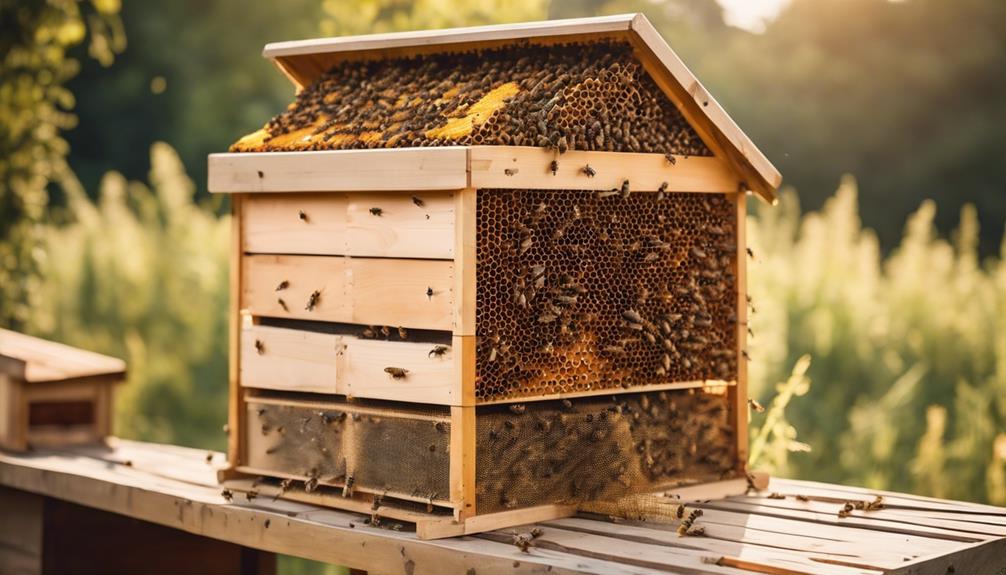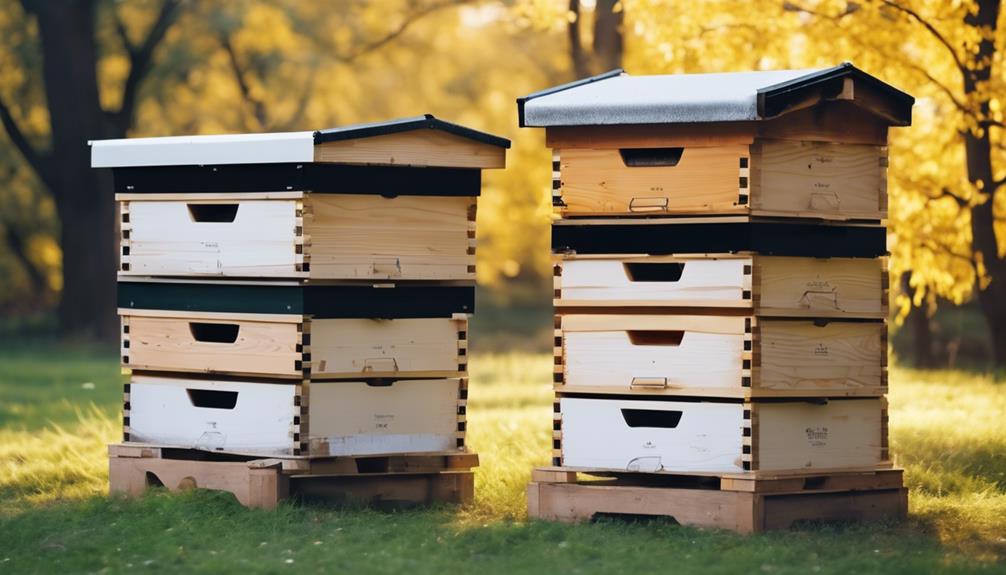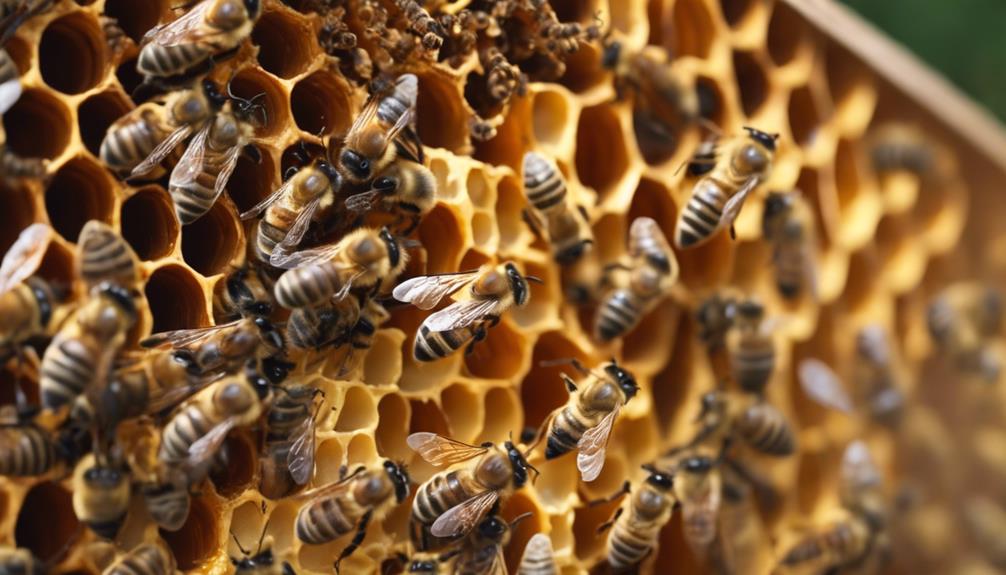When venturing into beekeeping, the best hive to start with largely depends on your budget, maintenance abilities, and beekeeping aims. The Langstroth hive, with its removable frames and easy expansion, is favored in commercial beekeeping circles. On the other hand, the Top Bar hive, known for its simplicity and cost-effectiveness, provides a beginner-friendly option. Meanwhile, the Warre hive promotes a more natural beekeeping approach with minimal intervention. Each hive type suits different needs and practices, emphasizing the importance of aligning your choice with your goals and preferences.
As you consider your best option, remember to investigate factors like ease of use, maintenance requirements, and overall costs to guarantee a harmonious start to your beekeeping journey.
Main Points
- Consider your budget, maintenance abilities, beekeeping goals, and physical capacity.
- Langstroth hives are versatile and suitable for beginners and commercial beekeeping.
- Top Bar hives offer simplicity and cost-effectiveness, great for beginners.
- Warre hives promote natural beekeeping methods with minimal intervention.
- Choose a hive that aligns with your goals, preferences, and beekeeping practices.
Factors to Consider When Choosing
When selecting a beehive, consider factors such as your budget, maintenance requirements, and beekeeping goals. Your budget plays a significant role in determining the type of hive that suits you best.
The maintenance level varies between hive styles, so it’s essential to choose one that aligns with the time and effort you can dedicate. Reflect on your beekeeping goals; whether you aim for honey production, pollination, or simply the joy of beekeeping, your hive choice should support these aspirations.
Additionally, your physical abilities and lifting capacity are vital considerations. For instance, a Langstroth hive may be more manageable for those with limitations compared to a top bar hive.
Langstroth Hive Overview
Langstroth hives, with their removable frames, are a popular choice among beekeepers. These hives offer easy inspection and manipulation of frames, making them ideal for beekeeping.
When starting out, understanding hive design types, frame management techniques, and beekeeper suit options is key for success.
Hive Design Types
Exploring hive design types, the Langstroth hive stands out as a versatile and efficient choice for beekeepers of all levels.
- Modular Design: Langstroth hives are like customizable bee apartments, with stackable boxes that can be easily expanded or reduced based on colony requirements.
- Removable Frames: These hives feature frames that can be taken out for inspection or honey extraction, allowing beekeepers to work with ease and precision.
- Commercial Appeal: Langstroth hives are popular in commercial beekeeping due to their scalability, facilitating efficient management of colonies and honey production.
Langstroth hives embody the spirit of freedom in beekeeping, offering flexibility and productivity that cater to both beginners and experienced apiarists alike.
Frame Management Techniques
The efficient design of Langstroth hives facilitates ideal frame management techniques for beekeepers, enhancing honey production and colony health. With Langstroth hives, frame management becomes a breeze. These hives boast removable frames that hold honeycomb, allowing for easy inspection, manipulation, and honey extraction.
This setup not only promotes efficient honey production but also helps prevent issues like overcrowding and swarming. The scalability of Langstroth hives makes them a top choice for commercial beekeeping, as beekeepers can easily expand their colonies by adding more frames.
Beekeeper Suit Options
When considering beekeeper suit options within the context of a Langstroth hive overview, comfort and protection are paramount factors to prioritize. Here are three key points to keep in mind when selecting your beekeeper suit:
- Top Bar Consideration: For beginning beekeepers using a Langstroth hive, a beekeeper suit that offers full coverage and ventilation is crucial for a comfortable beekeeping experience. Look for suits that provide ample protection while allowing airflow to prevent overheating during hive inspections.
- Frequent Inspections: Since Langstroth hives facilitate regular inspections for maintaining healthy bees, opt for a suit that’s durable and easy to clean. This will make sure that you can suit up quickly for routine hive check-ups without compromising on cleanliness.
- Beekeepers’ Choice: Many experienced beekeepers use suits with multiple pockets and reinforced seams for added convenience and longevity. Prioritize suits that come recommended by seasoned beekeepers to guarantee both quality and functionality in your beekeeping journey.
Top Bar Hive Overview
Top Bar hives offer a unique horizontal design with wooden bars for bees to build their comb. This setup mimics the bees’ natural comb structure, making it a favorite among small-scale beekeepers.
The simplicity and cost-effectiveness of Top Bar hives make them an excellent choice for those looking to start their beekeeping journey.
Design Features
With a horizontal design and wooden bars for comb building, top bar hives offer a unique approach to beekeeping. Here are some key design features to take into account:
- Bees Build Comb: In top bar hives, bees have the freedom to construct their comb without the constraints of pre-made frames, allowing for a more natural beekeeping experience.
- Hive Design: The straightforward and cost-effective design of top bar hives makes them an excellent choice for new beekeepers looking for a hands-off approach that aligns with the bees’ natural behavior.
- Require More Frequent Inspections: Due to their design, top bar hives necessitate more regular inspections to prevent potential issues like overcrowding or swarming. This hands-on approach can provide valuable learning opportunities for beekeepers while ensuring the well-being of the colony.
Beekeeping Experience
For beginners starting their beekeeping journey, the experience of managing a top bar hive offers a simplified and natural approach to tending to bees. Unlike traditional hives, top bar hives are designed with simplicity in mind, making them perfect for those new to beekeeping.
The lack of heavy lifting associated with traditional hive boxes eases the workload for beginners, allowing for a more enjoyable beekeeping experience. With top bar hives, bees are encouraged to build comb freely, mirroring their natural behavior without the need for frames or foundation.
Regular inspections are important to prevent issues like overcrowding and swarming, but the process is straightforward and rewarding. Additionally, the cost-effective nature of top bar hives and their suitability for small-scale beekeepers make them an excellent choice for those just starting out.
Warré Hive Overview

Developed by Émile Warré in the mid-20th century, the Warré Hive is designed for natural beekeeping and features a vertical top bar design with uniformly sized stacked boxes.
Here are three key points about the Warré Hive:
- Natural Beekeeping: The Warré Hive encourages honey bees to build comb downwards from top bars, mimicking their natural behavior and promoting a more organic approach to beekeeping.
- Low-Intervention Practices: With minimal maintenance required, this hive is ideal for beekeepers looking to minimize their intervention, allowing the bees to thrive with little human interference.
- Vertical Design: The vertical structure of the Warré Hive allows bees to expand their colony in a way that closely resembles their natural instincts, providing a more harmonious environment for the bees.
Comparison of Hive Types
Let’s compare different types of bee hives to determine their suitability for various beekeeping practices.
Langstroth hives are great for beginners, offering easy access to resources and mentorship. They’re also favored in commercial beekeeping for their efficiency.
Top Bar hives, on the other hand, present a simpler and cost-effective option, mimicking natural comb structures and being ideal for small-scale beekeeping ventures.
Warre hives promote natural beekeeping methods, requiring minimal intervention and offering a holistic approach to beekeeping.
Each hive type caters to different needs, whether it’s the practicality of Langstroth hives for commercial operations or the simplicity and natural focus of Top Bar and Warre hives for beginners and those interested in natural beekeeping practices.
Pros and Cons of Each Hive

When considering the pros and cons of each hive type, it becomes evident that Langstroth, Top Bar, and Warre hives offer distinct advantages and disadvantages tailored to various beekeeping preferences and goals.
- Langstroth Hive
- Pros: Easy inspection and manipulation of frames for efficient honey extraction.
- Cons: Requires more frequent inspections and maintenance, ideal for commercial operations.
- Top Bar Hive
- Pros: Mimics natural comb structure, cost-effective, and promotes natural beekeeping.
- Cons: More frequent inspections needed to prevent overcrowding and swarming.
- Warre Hive
- Pros: Emphasizes natural beekeeping and requires minimal intervention.
- Cons: Less suited for easy inspections but environmentally friendly and promotes bee health.
Making the Best Decision
Taking into account your beekeeping goals and preferences is vital in determining the best hive to start with. When choosing a hive style, like the Top Bar hive or the classic Langstroth hive, it’s essential to think about how it aligns with your aspirations as a beekeeper.
Consider factors such as the hive’s ease of use, maintenance requirements, and cost. Consulting experienced beekeepers or mentors can provide valuable insights to guide your decision-making process.

Hello! My name is Noel Calvin. I graduated from UCLA and now work as a writer at Launch Ninjas. I write blog posts that inspire and guide our readers in their entrepreneurial pursuits. I live in Pleasantville, NJ, with a peaceful yet lively atmosphere that inspires me.
Writing stories is more than just a job for me. It allows me to share my observations and satisfy my curiosity about the world. I combine my analytical skills with creative enthusiasm to delve into technology trends and startup stories. But my life isn’t limited to screens and keyboards. I value loyalty, passion, and a touch of old-fashioned charm, which I infuse into every narrative I create.
I love spending time in my garage, jamming with my band when I’m not writing. Playing the guitar and singing bring me immense joy. I also enjoy capturing ordinary and extraordinary moments through my camera lens and exploring new culinary adventures that excite my taste buds. I’m always seeking new experiences.
My family is very important to me. Joyful Sunday brunches filled with laughter and intense board game nights keep me grounded, reminding me of life’s simple pleasures.
In my world, every moment is an opportunity for discovery. Every discovery is a story worth sharing, whether a heartfelt moment at home or the pulse of technological innovations. Join me as I navigate through life, one blog post, one guitar strum, and one heartwarming family dinner at a time.


